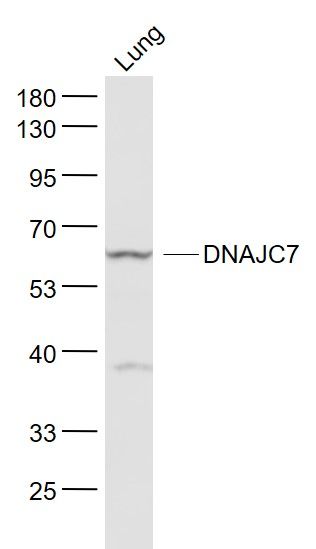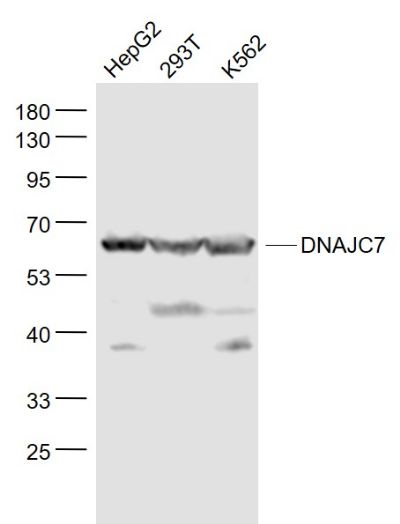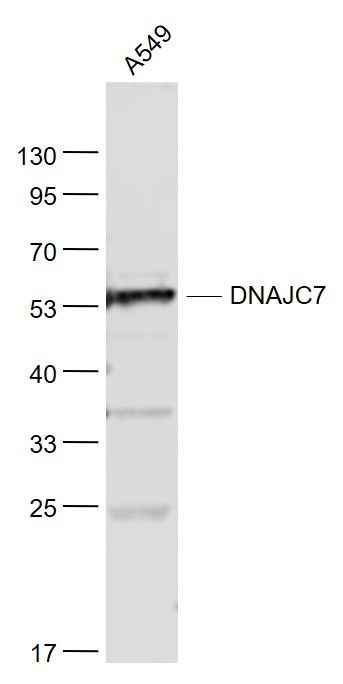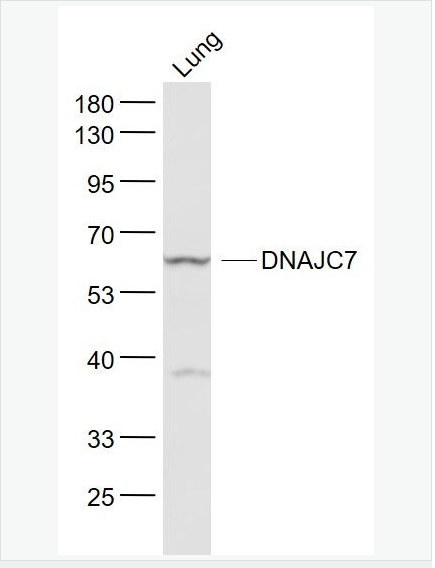| 中文名稱 | DNAJC7蛋白抗體 |
| 別 名 | DnaJ homolog subfamily C member 7; Tetratricopeptide repeat protein 2; TPR repeat protein 2; TPR2; TTC2; DNJC7_HUMAN. |
| 研究領(lǐng)域 | 腫瘤 細(xì)胞生物 免疫學(xué) 神經(jīng)生物學(xué) |
| 抗體來(lái)源 | Rabbit |
| 克隆類型 | Polyclonal |
| 交叉反應(yīng) | Human, Mouse, Rat, (predicted: Chicken, Dog, Pig, Cow, Horse, Rabbit, ) |
| 產(chǎn)品應(yīng)用 | WB=1:500-2000 ELISA=1:500-1000 not yet tested in other applications. optimal dilutions/concentrations should be determined by the end user. |
| 分 子 量 | 56kDa |
| 細(xì)胞定位 | 細(xì)胞核 細(xì)胞漿 |
| 性 狀 | Liquid |
| 濃 度 | 1mg/ml |
| 免 疫 原 | KLH conjugated synthetic peptide derived from human DNAJC7:221-320/494 |
| 亞 型 | IgG |
| 純化方法 | affinity purified by Protein A |
| 儲(chǔ) 存 液 | 0.01M TBS(pH7.4) with 1% BSA, 0.03% Proclin300 and 50% Glycerol. |
| 保存條件 | Shipped at 4℃. Store at -20 °C for one year. Avoid repeated freeze/thaw cycles. |
| PubMed | PubMed |
| 產(chǎn)品介紹 | The DnaJ family is one of the largest of all the chaperone families and has evolved with diverse cellular localization and functions. The presence of the J domain defines a protein as a member of the DnaJ family. DnaJ heat shock induced proteins are from the bacterium Escherichia coli and are under the control of the htpR regulatory protein. The DnaJ proteins play a critical role in the HSP 70 chaperone machine by interacting with HSP 70 to stimulate ATP hydrolysis. The proteins contain cysteine rich regions that are composed of zinc fingers that form a peptide-binding domain responsible for the chaperone function. DnaJ proteins are important mediators of proteolysis and are in-volved in the regulation of protein degradation, exocytsis and endocytosis. DnaJC7 (DnaJ homolog subfamily C member 7), also known as TPR2, TTC2 or DANJC7, is ubiquitously expressed, with highest expression in testis, liver, heart and brain. Function: Acts as co-chaperone regulating the molecular chaperones HSP70 and HSP90 in folding of steroid receptors, such as the glucocorticoid receptor and the progesterone receptor. Proposed to act as a recycling chaperone by facilitating the return of chaperone substrates to early stages of chaperoning if further folding is required. In vitro, induces ATP-independent dissociation of HSP90 but not of HSP70 from the chaperone-substrate complexes. Recruits NR1I3 to the cytoplasm (By similarity). Subunit: Associates with complexes containing chaperones HSP70 and HSP90. Interacts with the GAP domain of NF1. Interacts with HSP90AA1. Interacts with HSPA1A/B; the interaction is enhanced by ATP. Interacts with HSP90AB1. Interacts with PGR. Interacts with RAD9A; the interaction is interrupted by UV and heat shock treatments. Interacts with HUS1 and RAD1. Interacts with NR1I3. The DNAJC7-NR1I3 complex may also include HSP90 (By similarity). Interacts with HSPA8. Subcellular Location: Cytoplasm. Nucleus. Cytoplasm, cytoskeleton. Similarity: Contains 1 J domain. Contains 9 TPR repeats. SWISS: Q99615 Gene ID: 7266 Database links: Entrez Gene: 7266 Human Entrez Gene: 56354 Mouse Entrez Gene: 303536 Rat Omim: 601964 Human SwissProt: Q99615 Human SwissProt: Q9QYI3 Mouse Important Note: This product as supplied is intended for research use only, not for use in human, therapeutic or diagnostic applications. |
| 產(chǎn)品圖片 |  Sample: Sample:Lung (Mouse) Lysate at 40 ug Primary: Anti- DNAJC7 (bs-8280R) at 1/1000 dilution Secondary: IRDye800CW Goat Anti-Rabbit IgG at 1/20000 dilution Predicted band size: 56 kD Observed band size: 58 kD  Sample: Sample:HepG2(Human) Cell Lysate at 30 ug 293T(Human) Cell Lysate at 30 ug K562(Human) Cell Lysate at 30 ug Primary: Anti- DNAJC7 (bs-8280R) at 1/1000 dilution Secondary: IRDye800CW Goat Anti-Rabbit IgG at 1/20000 dilution Predicted band size: 56 kD Observed band size: 58 kD  Sample: Sample:A549(Human) Cell Lysate at 30 ug Primary: Anti- DNAJC7 (bs-8280R) at 1/1000 dilution Secondary: IRDye800CW Goat Anti-Rabbit IgG at 1/20000 dilution Predicted band size: 56 kD Observed band size: 56 kD  Tissue/cell: rat brain tissue; 4% Paraformaldehyde-fixed and paraffin-embedded; Tissue/cell: rat brain tissue; 4% Paraformaldehyde-fixed and paraffin-embedded;Antigen retrieval: citrate buffer ( 0.01M, pH 6.0 ), Boiling bathing for 15min; Block endogenous peroxidase by 3% Hydrogen peroxide for 30min; Blocking buffer (normal goat serum,C-0005) at 37℃ for 20 min; Incubation: Anti-DPP9/DPRP2 Polyclonal Antibody, Unconjugated(bs-8294R) 1:200, overnight at 4°C, followed by conjugation to the secondary antibody(SP-0023) and DAB(C-0010) staining |
我要詢價(jià)
*聯(lián)系方式:
(可以是QQ、MSN、電子郵箱、電話等,您的聯(lián)系方式不會(huì)被公開(kāi))
*內(nèi)容:









